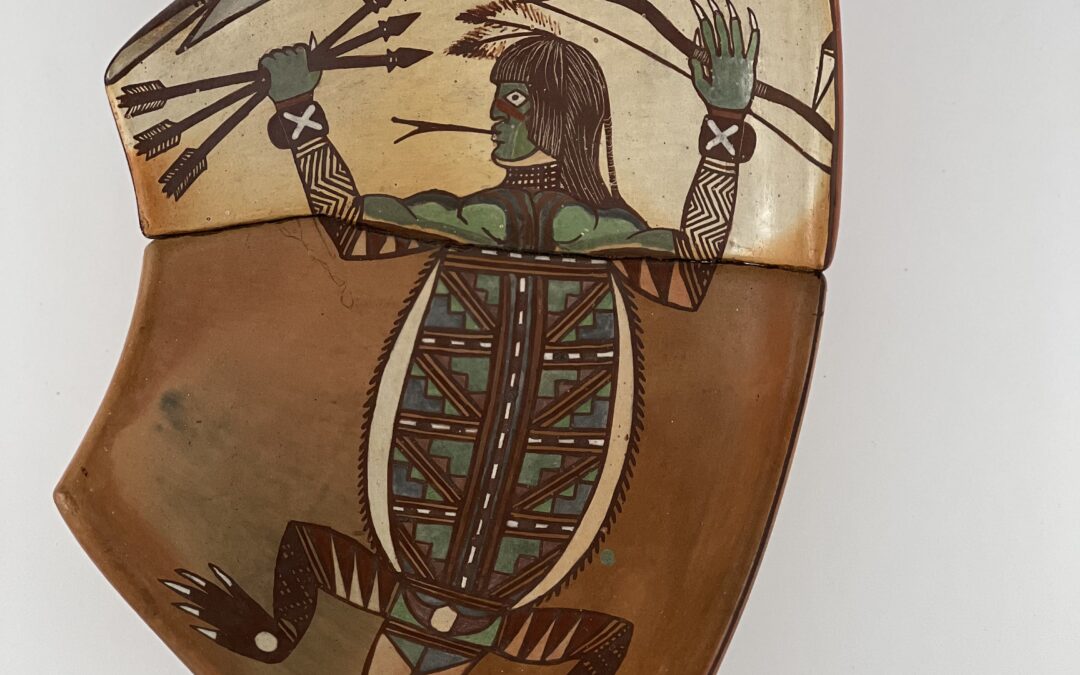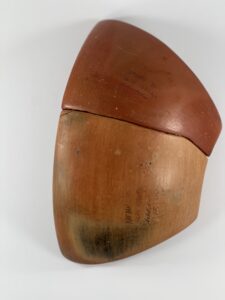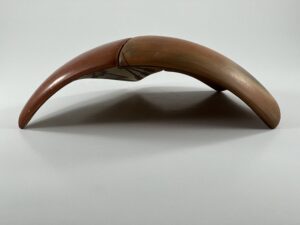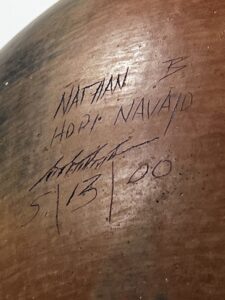The shards are 0.3125” thick.
This pot consists of two shards displaying the results of shapeshifting between a lizard and a man. There is something both unsettling and alluring about bodily transformations between humans and animals, Such metamorphosis occurs in the mythologies of Pueblo people, but I do not know if Nathan had this tradition in mind when he created this pot or if the image is simply a product of his extraordinary creativity.
The pot was part of a two-pot box-lot, the second pot also being two-shard and depicting a man with a fish head (2023-03). Though these pots have the format of a broken pot, the form is intentional. Nathan used this device for a pot that joined this collection 9 years ago, though that pot is composed of 5 shards and has a completely geometric design (2013-10).
Form:
The overall pot is roughly “W” shaped, the cross section of a flared bowl. Two sides are parallel but are of different lengths. One is about 3.5-inches long, the other 9.25-inches long, both measured with a straight ruler point-to-point. As a result the remaining two sides of the pot are angled to accommodate this difference. The boundary between the shards is fairly straight except for one noticeable angle. When turned over the pot has the shape of half a bowl with what would have been the center of the bowl forming a large arch and what would have been the edge of the bowl forming a smaller, parallel, arch.
The outside of the top shard fired a consistent brown. The exterior of the bottom shard has a more variegated and lighter golden color with a noticeable smudge mark where the fire touched the pot. Both shards are inscribed on their exterior:
Nathan B
Hopi Navajo
cloud cypher
5/13/00
the last line being the date of production.
Design:
The design can be thought of as being in three panels: 1) the body of the man lizard on the larger, lower, shard, 2) the head of the man lizard and his arms holding arrows and a bow on the top, smaller, shard, and 3) a band of iconographic designs above the man’s head along the upper edge of the upper shard.
Lower shard:
The central lower body is entirely lizard and displays a symmetrical design. The skeletal structure is represented by black lines overpainted with while stripes. The spine carries 11 such white markings; each of the 6 ribs displays 3 white stripes. The 3 sets of ribs segregate the body of the lizard into 8 segments, 4 on each side of the central spine. The design in each of the eight segments is the same, except that the design of the lower segment is truncated by curving edge of the torso. Parallel to each side of each rib are two black lines (“one-lane highways”), the space between painted brown. From the upper outer corner of each segment, a similar element slopes diagonally across the space to the lower center corner. This element is composed of three parallel lines (a “two-lane highway”) and is also brown. Each of the 8 square segments of the torso is thus divided by the diagonal into 2 triangles. Painted on both sides of the diagonals are three conjoint small triangles. The set above the diagonal is colored a medium mauve; the set below the diagonal is a light blue. The residual corner space on either side of the diagonal is L-shaped, the top L a light blue and the bottom L a darker blue. As noted, the lowest of the 4 pairs of segments is truncated because the torso curves inward to join the lower legs. In these two segments the area below the diagonal is reduced to a small dark-blue triangle. Both sides of the torso are bordered by a long curving white arc of paint, its outer edge displaying 30 to 32 fine black hairs.
The legs are divided into three segments: thigh, calf and claw. The thigh is painted with three conjoint downward-pointing dark-mauve triangles. The residual space forms three upward-pointing white triangles. The calfs are separated from the thighs and paws by unpainted two-lane “highways.” The design of the calf is complicated. It appears that Nathan first filled this space with a crosshatch of black lines and then overlay the resulting grid with broad zig-zag lines of dark mauve paint. The result is a dark, textured and muted design. The terminating claws are roughly the shape of a human hand with five long and fierce nails. The nails are painted white and the rest of the claw is dark mauve except for a solid white disk near the palms.
The two legs are separated by a rectangular space edged with brown two-lane highways at its top and bottom and brown one-lane highways at its sides. At the center of this rectangle is a solid white dot, perhaps the anus. On either side of this dot emerge upward-curving light-mauve horns. The residual space in the rectangle is light blue. A large tail emerges from the lower side of this blue rectangle, broad at its base and narrowing toward a tip that rests on the upper corner of the shard.
A black line runs down the center of the tail. Strung along it are a series of light and dark blue triangular forms that decrease in size as they approach the tip of the tail. First is a set of right triangles, their base resting on the two-lane highway above. The right triangle is painted a darker blue, the right triangle a somewhat lighter blue. Thereafter sets of triangles are grouped into diamond shapes composed of four triangles. The upper left and lower right triangles carry a a darker blue paint while the remaining two triangles are lighter blue. The difference in the coloring of the pairs of triangles is clearer for the first four diamonds but becomes more ambiguous as the three remaining diamond shapes get smaller and approach the tip of the tail.
A fraction of the arms is depicted on the lower shard: triceps are seen here as a series of interlocking brown and unpainted triangles followed by three parallel lines (a two-lane highway). Beginning with the elbows on the lower shard and extending on the forearms on the upper shard is a design of brown zig-zags against an unpainted background.
Upper shard:
The design on the upper shard is more complicated than that on the lower shard and is not symmetrical. The dark blue color along the spine of the lower shard continues upward onto the upper shard and spreads across the center of the upper chest and the top of the biceps of the creature. Almost invisible are semi-circular black elements that underlie this dark blue and are noticeable mostly because their curved ends intrude in to the neighboring light-blue color. Together the dark and light blue colors form the creature’s biceps, which seem to appear twice on the left arm (viewer’s perspective) and once on the right arm.
The zig-zag pattern of the forearms ends with three parallel brown lines (another two-lane highway) followed by thick, puffy brown bracelets marked with large white Xs. Following a single band of brown (a one-lane highway), are blue hands or claws. The left hand (viewer’s perspective) clutches a group of three brown arrows. The right hand is open and shows the same long reptilian nails found on the feet. Held between the thumb and first finger of this hand is a brown recurved bow.
A band of cross-hatched design marks the neck. The blue face is presented in profile, the lower edge of its jaw a sloped white edge. The shape of the face (eye, nose and mouth) are entirely human, but out of its mouth projects a forked reptilian tongue. The long hair and braid mark this being as Native. Further emphasizing its heritage are two (eagle?) feathers projecting forward from the top of its head.
Upper band of designs:
Above the head is a band of 9 rain clouds. One has the rain emerging from the stepped form of a cumulus cloud with a triangle (woman = fecundity) embedded at its center. To its right is a form of red, yellow and blue domed clouds dropping a curtain of rain. To their right is the tabula of a Hemis kachina with multi-colored phallic forms and rain pouring from its lower edge. Floating above these forms are four full and two partial representation of a different rain cloud: white domes interspersed with bi-lobed crosses, the symbol of dragonflies found near water. Again, rain flows from the lower edges of these clouds. Notice that all but one of these cloud blessings are presented against a sky-blue, notched, background. Fit along the lower edge of the right notch is a wedge of brown containing the Hemis tabula rain cloud.
Design Analysis:
As with the other metamorphic shard pot in this collection (2023-02), the arms of the creature are largely depicted on the upper shard, but intrude slightly onto the lower shard, thus helping unify the design across the shards. The symmetrical design on the lower shard contrasts with asymmetric design on the upper shard, creating tension and interest in the design.
The interlocking rows of triangles on the thighs of the creature create a sense of foreground/background reversal which energizes this section of the design. The layered painting of the calfs of these legs result in a dark, textured and muted design. This dark format extends to the feet, also a dark brown. These two darker sections give the hind legs a heavy, powerful, sensibility which weighs the image down. This powerful appearance is reinforced by the long, sharp claws on each of the hind feet. The three white circles marking the hind feet and the anus further unify this section of the design. Contrast the heavy power of the reptilian hind legs with the lighter and delicate zig-zag design on the upper, more-human, legs.
The underlying black lines on the central chest are almost invisible except where they intrude into the surrounding lighter-blue areas. These lines are fairly carefully-drawn, but seem discordant, out-of-place and without a clear purpose. The figure seems to have two biceps on each arm. All-in-all, the chest/bicep area of the figure seems a bit jumbled.
Because its nails cannot be seen, the left hand seems human-like. Because the right hand is open and displays its claw-like nails, it seems more like a lizard claw. Thus the human/reptilian theme of the pot is reflected in the contrasting details of these hands.
The cross hatching on neck might represent a necklace.
Unlike shard pot 2023-03, this shard pot shows a single, coherent figure, making an understanding of the design more certain. Rain clouds are a symbol of blessing in this dry desert environment. The blue background may represent the sky. The wedge of brown to the right of the Hemis phallic symbols may represent the earth receiving this gift. Overall the bevy of clouds raining blessings on the figure below portends that this magical hunter will be rewarded and his people will eat, the core blessing of a desert life. Excavations at a number of ancestral pueblos have uncovered mythic kiva murals that seem to have been drawn as requests to the gods for a bounty of crops and game. I am not aware that any of the excavated images have the form of the man lizard on pot 2023-04, but the format and iconography of Nathan’s modern vision seems of the same spirit as the murals of his Hopi ancestors. This shard-pot is a blessing.
Very similar reptiles hunt ants on another Nathan pot in this collection (2014-04) which was created four months before this shard pot. Very similar hair feathers appear on another Nathan pot in this collection, 2015-02.
A review:
I have become particularly enamored of Nathan’s pottery since buying my first piece ten years ago. The order in which I purchased the fifteen Nathan Begaye pieces in this collection, however, does not reflect the order in which they were created. Since all except the oldest are dated, it is possible and instructive to reorganize this pottery into the sequence in which they were made. The pottery in this collection spans a period of 33 years:
Name Catalogue number Date produced
Red slip pot 2013-01 about 1973
Star jar 2018-10 10-30-86
Shepard with sheep 2022-16a,b,c 3-2&7-91
Moon face canteen 2017-06 1-25-94
Anasazi-inspired bowl 2019-24 10-25-96
Mask 2023-02 4-1-97
Maiden effigy pot 2019-20 12-5-97
Toads hunting ants pot 2014-04 1-16-00
Lizard man shard pot 2023-04 5-13-00
Fish man shard pot 2023-03 5-17-00
Abstract shard pot 2013-10 6-14-00
Incised canteen 2013-09 1-25-02
Incised serpent pot 2022-15 1-25-02
Tawa plaque 2017-07 2005
Nude male bowl 2015-02 9-5-06
I see three periods of production here:
First, the red slip pot (about 1973) is extraordinary because of its size, bulbous shape, thinness, dramatic red color and its Sikyatki-inspired but innovative design. Very few Hopi or Hopi-Tewa potters of any age can do work this fine. That it was done by a boy in his early adolescence is unnerving. Its Sikyatki style is the most traditional among the Begaye pots in this collection.
The second category of pots, from 1986 through 2002, contains 12 of the 15 pots in this collection and represents Nathan using his full creative power. Each of these pots has a unique form or design, though we are beginning to see some patterns. All three shard pots were created within about a month of each other in 2000. The two incised pots were fired on the same day in 2002. As with many artists, apparently Nathan experimented for a while with one technique and form and then moved on to explore a different expression. Because this collection contains a rather large number of Nathan’s pots, these patterns emerge.
The final group of two pots have a poignancy about them that is not apparent in his earlier work. These are among the last pots Nathan created before he stopped potting several years before a long illness and death. While the Tawa plaque is full of blessing and seems to incorporate the artist into this vision of hope, the note that Nathan wrote to acompany the plaque is full of bitterness and dispair. Finally I read a similar message of personal despair into the image of the nude, truncated, Native male on the 2006 bowl. For me this image is the emotional equivalent at looking at Emile Serate’s painting of a freshly butchered cow.
Nathan stopped making pots sometime during the last five years of his life; he died on December 21, 2010. However the collection does contain a drawing he made dated 4-13-2008:
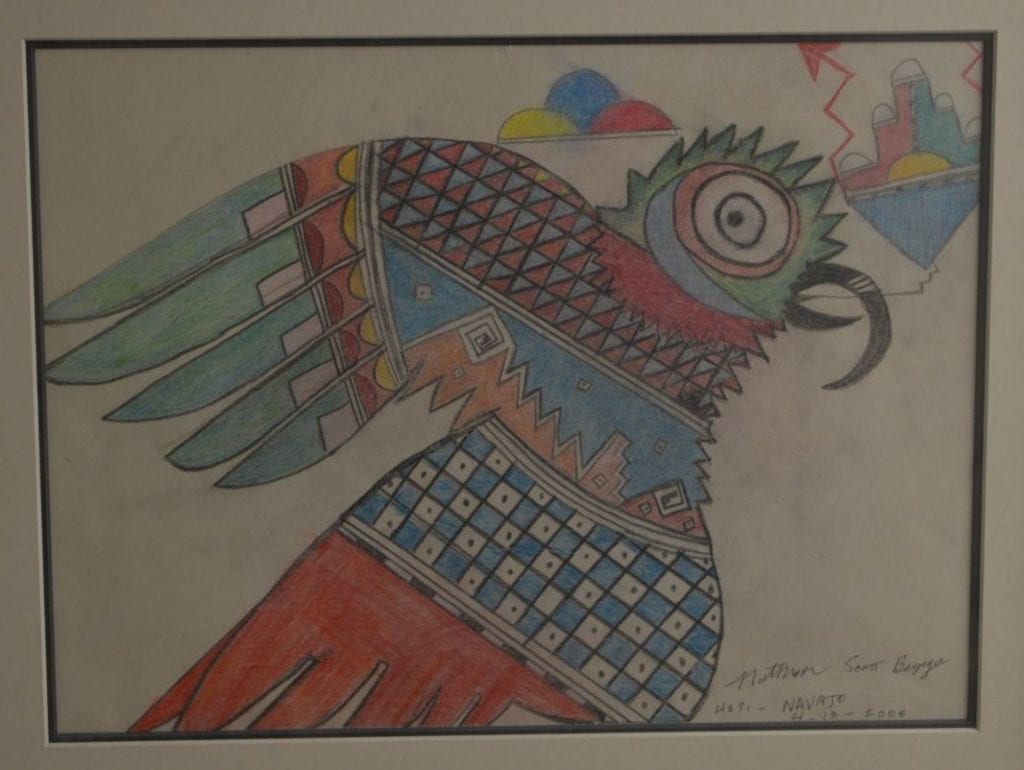
It’s speculation on my part, but drawing on a piece of paper is a simpler process than forming, painting and firing a pot, so perhaps Nathan turned to drawing as an artistic outlet during his final years when he was ill. Unusually –but like Tawa plaque 2017-07-– Nathan added his middle name “Scott” when signing this drawing. The image of a creature with symbols emerging from its mouth is an ancient Hopi motif; see bowl 1997-05 in this collection. Such images are generally understood as germination prayers, though it is not possible to know what a potter 600 years ago intended. I do not know what meaning, if any, Nathan attached to this drawing, but the element emerging from the mouth is a rain cloud, a clear blessing in the desert southwest. Germination and renewal might be concerns of a person near the end of his life. At least the drawing does not reflect the anger I perceive in the poem accompanying pot 2017-07 or the image on plate 2015-02, both created during his period of decline.

